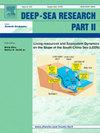西印度洋偏远岛屿绿海龟幼崽遗传起源的时间稳定性
IF 3
3区 地球科学
Q2 OCEANOGRAPHY
Deep-sea Research Part Ii-topical Studies in Oceanography
Pub Date : 2025-09-11
DOI:10.1016/j.dsr2.2025.105545
引用次数: 0
摘要
对海洋生态系统日益增加的人为和气候压力引起了人们对其功能、利用和保护的可持续性的关注。海龟等海洋巨型动物由于其生命周期和生命周期中栖息地的可变性,特别容易受到这些压力的影响。了解幼鱼种群动态对环境条件的响应对于设计有效的保护策略至关重要。本研究调查了绿海龟幼龟在招募地点的基因组成是否随时间而变化。在西南印度洋swo的四个主要招募地点(格洛里厄斯、马约特、留尼汪和阿尔达布拉),共有346只幼鱼在两个采样阶段取样,间隔时间为6至17年,具体取决于地点。基于mtDNA控制区序列,比较了每个位点内不同时期的遗传结构。即使遗传组成的细微变化可能无法用当前的遗传分辨率检测到,我们的结果表明,幼绿海龟种群的结构在研究期间没有显着变化。这种种群结构的稳定性可能与近几十年来西南大西洋区域洋流的稳定性有关,也可能与不同区域遗传种群的筑巢种群动态有关,这些种群对区域绿海龟幼崽的生产起着重要作用。本文章由计算机程序翻译,如有差异,请以英文原文为准。
Temporal stability in genetic origin of juvenile green turtle recruits at remote western Indian Ocean islands
The increasing anthropogenic and climatic pressures on marine ecosystems raise concerns about the sustainability of their functions, uses and conservation. Marine megafauna such as marine turtles are particularly vulnerable to these pressures due to their life cycle and the variability of habitats they occupy during their life cycle. Understanding how juvenile population dynamics respond to environmental conditions is crucial for designing effective conservation strategies. The present study investigates whether the genetic composition of juvenile green turtles at recruitment sites changes over time. A total of 346 juveniles were sampled at four key recruitment sites in the South Western Indian Ocean - SWIO (Glorieuses, Mayotte, Reunion and Aldabra) during two sampling phases at an interval between 6 and 17 years depending on the site. Based on mtDNA control region sequences, genetic structures were compared between periods within each site. Even if subtle changes in genetic composition may not be detectable with current genetic resolution, our results suggest that the structure of the juvenile green turtle population has not significantly changed over the course of the study period. Such stability in population structure may be correlated with the stability of regional oceanic currents over the last decades in the SWIO, as well as the dynamics of nesting populations in the different regional genetic stocks contributing in regional juvenile green turtle production.
求助全文
通过发布文献求助,成功后即可免费获取论文全文。
去求助
来源期刊
CiteScore
6.40
自引率
16.70%
发文量
115
审稿时长
3 months
期刊介绍:
Deep-Sea Research Part II: Topical Studies in Oceanography publishes topical issues from the many international and interdisciplinary projects which are undertaken in oceanography. Besides these special issues from projects, the journal publishes collections of papers presented at conferences. The special issues regularly have electronic annexes of non-text material (numerical data, images, images, video, etc.) which are published with the special issues in ScienceDirect. Deep-Sea Research Part II was split off as a separate journal devoted to topical issues in 1993. Its companion journal Deep-Sea Research Part I: Oceanographic Research Papers, publishes the regular research papers in this area.

 求助内容:
求助内容: 应助结果提醒方式:
应助结果提醒方式:


